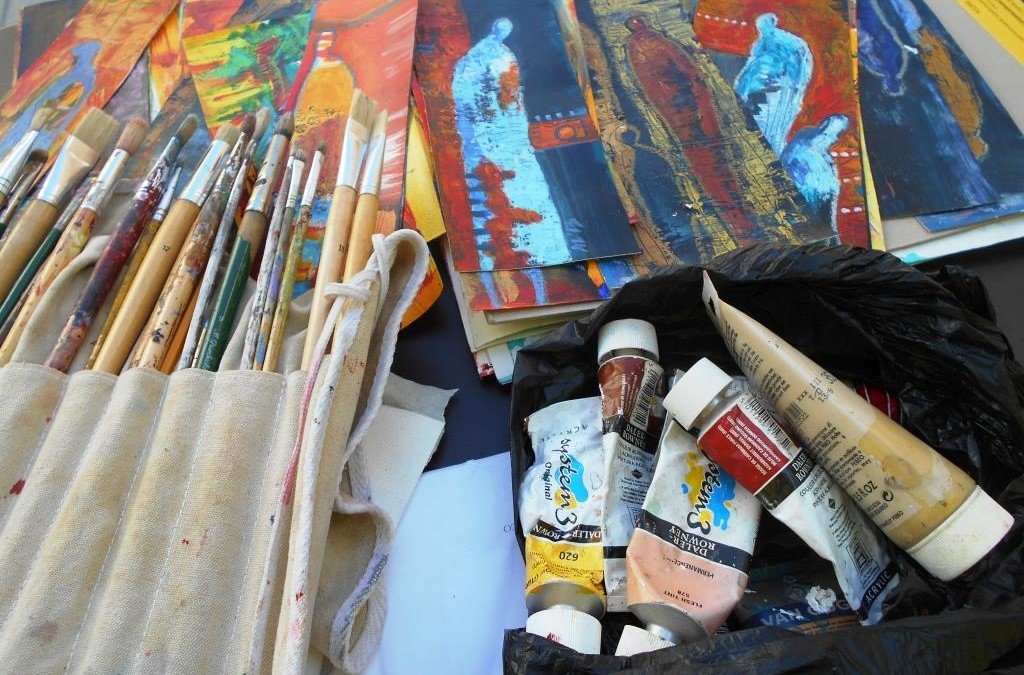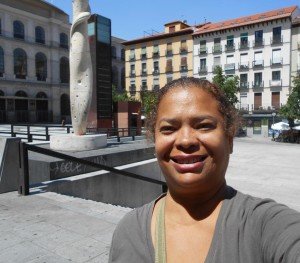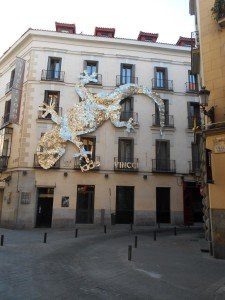FRIDAY 1 AUGUST
I am writing this in Madrid airport, while waiting to board my flight to Barcelona. I have not quite recovered from yesterday’s visit to the Sofia Museum. Good thing I had a big breakfast, and was wearing my sneakers. The building is at the end of a wide alley flanked with bistros and eateries, which use almost all of the walking space for their customers’ al fresco dining pleasure.
I stopped a police officer – not sure which one it was, since there are two kinds – and over the din of a nearby jackhammer, I asked donde esta el museo Sofia? and he pointed al la izquerda, to my left. I noted his fleeting grimace, and truly hoped it was the noise from the jackhammer, and not my mangling of his language.
The museum squats on the edge of a square parade, a monolith of stone and twin glass elevator towers. The true beauty of the space is inside; it reminds me of a convent or a monastery – long corridors, high ceilings, and, despite the many visitors, a hushed reverence – for the space or for the art, hopefully both.
I went to the Sofia for one reason. Guernica. Picasso’s famous depiction of his feelings about the Spanish Civil War. I took my time to get to it, starting at the suggested exhibitions, and thoroughly enjoying myself, as I was allowed to take photos – without flash – of almost all the pieces that intrigued me, including an exhibition of drawings and paintings about old time European carnival.
When I got to Guernica, on its own on a long wall, I noticed its size and that it enjoyed 2 docent escorts, one on each side. They were standing when I first looked into the room. Over 20 people were in there, including children, and I believe the escorts were ready to pounce on any who would breach the 10 foot deep barrier between audience and artwork, or heaven forbid, try to sneak a photo. As well they should.
In 2010, working from internet images, I translated Guernica using the Grenada ShortKnee. It was part of my 2011 show called ICON: ShortKnee as Art. My version presently occupies a wall in a collectors’ flat in London. But to see Guernica in the flesh, I saw many elements I had not noticed in the images I worked from. The main reasons I chose Guernica to reinterpret were (i) the motion of the woman to the front right of the painting. She stalks like the ShortKnee – that loping forward motion with arms parallel to the ground, and one leg mid–genuflection. And (2) the features of the people showing the African mask influence that Picasso used in his work. My version is in colour on recycled packing paper. His, originally in colour, according to the blurb, was repainted in shades of black and grey.
The details I missed were the hairy armpits, tiles on the roof, the teeth of the horse, pulling out of their roots and dribble, saliva running down, as well as remnants of underdrawing and underpainting visible, from 10 feet away. I really needed to get closer to the piece, and I went to the barrier and took my time walking from one end to the other, tilting my head back and talking to myself, making mental notes. I quite fogot that I was blocking some visitors, that I may have been freaking out the escorts – I was quite mesmerised by what I was seeing, and itching to try another Guernica translation.
I have often said that to see and smell a particular work of art leaves a lasting impression on the future works of an artist, like hearing your favourite author speak, or seeing your favourite soca artists in concert. For many of our younger (in age or in making art) artists, there is little opportunity to travel to see and smell the works. What is required is a project to be written to take a good handful on a museum crawl in the UK perhaps, and then arrange to have some works shown here. The former is possible, the latter, given we have neither national gallery nor formal supportive infrastructure, may not happen any time soon.
Back to the Sofia – I found loads of inspiration, and I was gratified that upon really close inspection of one of Spain’s foremost artists, Juan Gris – whose Pierrot paintings I have reinterpreted with the ShortKnee – that Gris did not always create a perfect, paint-to-the-lines painting. In fact there was a lot of bare and spare canvas on show. Such was the case with some other artists – loose brushstrokes, underpainting and underdrawing left visible, to denote the expression, the feel the artist intended, and not the precision of an architectural drawing.
I returned to the hostel, chewing over what I had seen, and making notes to self about future creations. En route, I stopped to take photos of this gecko crawling down a building.
Brain working overtime, I could not sleep, and 2am this morning found me up in the common room, painting. The brief stop in Madrid has invigorated me. I am so ready for Slovenia. Bring on the paint!



